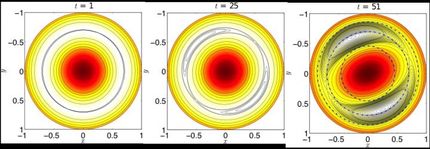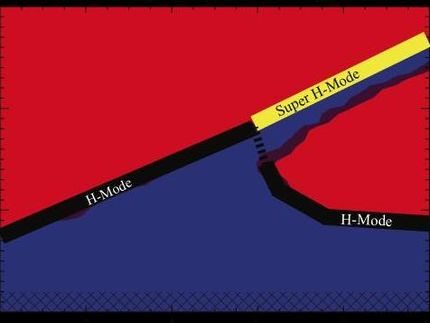Model predicts scenarios for energy generation using nuclear fusion
nuclear fusion, for the controlled and regular generation of electric power by converting hydrogen into helium and reproducing on a small scale what happens in our Sun (as well as other stars), is one of the foremost technological promises for the decades ahead.
Designed to reach parameters beyond the ones previously obtained in laboratory experiments, the reactor prototype called ITER - "the way" in Latin - is presently under construction in southern France. Its design capacity is for 500 megawatts, and the plan is to go live in 2025. The members of the ITER consortium are China, the European Union, India, Japan, Russia, South Korea and the United States. The cost of the megaproject is expected to surpass €20 billion.
ITER will is not intended to provide electricity to the grid, but it will be the first tokamak to produce net energy, i.e., more energy is released from fusion reactions than the amount of energy injected to heat the plasma. It will enable scientists to learn more about handling the multiple technical complexities of nuclear fusion, paving the way for machines that do indeed use it to supply electricity to the grid. The term tokamak comes from the Russian acronym for a toroidal chamber with magnetic coils.
For this plan to succeed, however, it will be crucial to ensure that the nuclear fusion process can become self-sustaining and to prevent losses of energy via electromagnetic radiation and of alpha particles - the atomic nuclei of helium made up of two protons and two neutrons -as these losses would allow the reactor to cool. Experimental results observed during the past 20 years have shown that the way in which fast ions (including alpha particles) are ejected from the plasma varies greatly from one tokamak to another. Until recently, no one understood which experimental conditions determined this behavior.
The problem has now been elucidated by Vinícius Njaim Duarte, a young Brazilian researcher who recently earned his PhD with support from the São Paulo Research Foundation - FAPESP in the form of a doctoral scholarship and a research internship abroad. Duarte is currently engaged in postdoctoral research at the Princeton Plasma Physics Laboratory (PPPL) in the US.
Duarte's research drew so much attention that at the largest US tokamak, DIII-D, developed and operated by General Atomics in San Diego, California, dedicated experiments were conducted to test the model he proposed. The results confirmed the model's predictions.
"Electromagnetic waves excited by fast particles in tokamaks can display sudden variations in frequency, known as chirping in the jargon. No one understood why this happened on some machines and not in others. Using complex numerical modeling and experimental data, Duarte showed that whether chirping occurs or not - and hence the nature of particle and energy losses - depends on the level of turbulence in the plasma confined in the tokamak, where nuclear fusion reactions take place. Chirping occurs if it isn't highly turbulent. With severe turbulence, there's no chirping," said physicist Ricardo Magnus Osório Galvão, now director of Brazil's National Space Research Institute (INPE) and former Duarte's PhD supervisor at the University of São Paulo's Physics Institute (IF-USP).
To make the import of this discovery comprehensible, a number of points must be explained.
First, it bears recalling that the process in question is nuclear fusion - not nuclear fission, the process used in the world's existing nuclear power plants. In fission, the atomic nuclei of heavy elements, such as uranium 235, for example, split into nuclei of lighter elements - krypton and barium in this case. This fission releases energy, electromagnetic radiation, and neutrons that in turn split in a chain reaction that keeps the process going.
Nuclear fusion works differently. In this process, the atomic nuclei of lighter elements, such as the hydrogen isotopes deuterium (one proton and one neutron) and tritium (one proton and two neutrons), fuse to form nuclei of heavier elements - in this case, helium (two protons and two neutrons) - and release energy.
"For nuclear fusion to be possible, it's necessary to overcome the electrostatic repulsion between positive ions," Galvão explained. "This only happens if the ionized gas [plasma] formed by the nuclei of the light elements is heated to extremely high temperatures, of the order of tens to hundreds of millions of degrees Celsius."
In ITER, for example, 840 cubic meters of plasma will be heated to 150 million degrees Celsius, over ten times the temperature of the Sun's core. "At that kind of temperature, you reach energy breakeven: the energy released by the fusion reactions is sufficient to equal the energy required to heat the plasma," Galvão said.
The process takes place inside the toroidal chamber of a tokamak, a device invented in the 1950s by Soviet physicists Igor Yevgenyevich Tamm and Andrei Sakharov, who were inspired by an original idea of their colleague Oleg Lavrentiev. A torus is shaped like a doughnut or an inner tube. The solid contained by the surface is known as a toroid.
The nuclear fusion process develops as follows. A vacuum is produced in the chamber, which is then filled with gas. An electric discharge ionizes the gas, which is heated by high-frequency radio waves.
An electrical field induced in the toroidal chamber subjects the gas to an extremely intense current of order of 1 million amperes in the case of DIII-D, which heats the gas even further via the Joule effect. Still more energy is injected by electromagnetic waves until the temperature required to trigger nuclear fusion is reached. Even a small tokamak, such as the one installed at the University of São Paulo, reaches temperatures on the order of millions degrees.
"At these extremely high temperatures, the ions vibrate so strongly that they collide and overcome electrostatic repulsion," Galvão said. "A powerful magnetic field confines the plasma flow and keeps it away from the vessel's walls. The highly energized alpha particles [helium nuclei] collide with other particles in the plasma, keeping it hot and sustaining the fusion reactions."
An analogy suggested by Galvão would be a bonfire made with damp wood, which will not catch fire easily at first but which flares up eventually after a certain temperature is reached, and the steadily more stable combustion produces enough energy to overcome the humidity. In the case of a plasma, it is said to reach the ignition point when alpha particles begin consistently feeding back into the process.
Control of turbulence
Among fusion's many advantages over fission is the fact that fusion involves a self-control mechanism: once the ignition point is reached, if this temperature level is significantly exceeded - in other words, if the plasma overheats - the reaction automatically slows down. Thus reactor meltdown, one of the most dangerous complications of accidents in power plants that use nuclear fission, could not happen in a nuclear fusion plant.
The problem - and we now return to Duarte's research - is that resonant interaction between alpha particles and waves present in the plasma can excite electromagnetic oscillations or even lead to the ejection of alpha particles. This can cause energy loss, plasma cooling and possible interruption of nuclear fusion. Understanding the causes of this problem and the factors that can prevent it is fundamental to ensuring the sustainability of the process and the use of nuclear fusion as a viable source of electricity.
"What Duarte found is that this outcome happens in a self-organized manner, with the production of chirping, if the plasma is not very turbulent. If turbulence is high, however, it doesn't," Galvão said [see below for an interview with Vinícius Njaim Duarte].
The crux of the problem is that in a highly turbulent fluid, there is no preferential direction, Galvão explained, offering another analogy to help illustrate his meaning.
"When you heat water slowly, you create a convection cell in the container. Hot water rises, and cold water sinks. This continues until all the water reaches boiling point," he said. "The medium then becomes turbulent, the convection cell is destroyed, and the energy spreads indiscriminately in all directions. This also happens in a magnetically confined plasma. Its occurrence prevents the creation of a self-organized system that sustains an undesirable associated electromagnetic wave. There isn't enough coherence for waves to be generated. So the loss of energy that would end the fusion process doesn't occur."
"Duarte had already published a paper on this model during his PhD research, but no one had performed an experiment to control the level of turbulence and see if the model applied or not. This has now been done by General Atomics on DIII-D, specifically in order to test the model, which was proven by the result."
Experimental physicists already knew empirically how to induce higher or lower turbulence, but they did not know this would affect the spectral nature of waves associated with the structures of particles. Duarte's contribution consisted of identifying the key control mechanism and explaining why. In terms of technological applications, this helps establish optimal turbulence - enough to prevent self-organized particle and energy loss but not enough to have other undesirable effects on overall plasma confinement.
Until now, tokamaks have been used on the laboratory scale. ITER will be the first prototype of a tokamak capable of generating electricity efficiently by nuclear fusion. The use of controlled nuclear fusion is not uncontroversial, but according to its advocates, it is safe, can produce a practically unlimited amount of power, and does not create radioactive waste, as do fission reactors.
Original publication
V. N. Duarte and H. L. Berk and N. N. Gorelenkov and W. W. Heidbrink and G. J. Kramer and R. Nazikian and D. C. Pace and M. Podestà and M. A. Van Zeeland; "Theory and observation of the onset of nonlinear structures due to eigenmode destabilization by fast ions in tokamaks"; Physics of Plasmas; 2017





























































